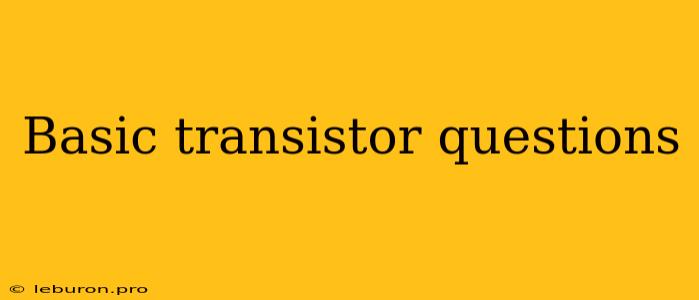The transistor, a ubiquitous component in modern electronics, is a semiconductor device that acts as a switch or amplifier. Understanding the basic transistor questions is crucial for anyone seeking to delve into the world of electronics, from hobbyists to engineers. This article will explore common questions about transistors, providing clear explanations and insights into their fundamental operation.
What is a Transistor?
A transistor is a semiconductor device that controls the flow of electrical current. It is made up of three layers of semiconductor material, usually silicon, with each layer doped with different impurities to create either a positive (p-type) or negative (n-type) charge carrier. These layers are arranged in two main configurations:
- NPN Transistor: Consists of an n-type layer sandwiched between two p-type layers.
- PNP Transistor: Consists of a p-type layer sandwiched between two n-type layers.
How does a Transistor Work?
A transistor works by controlling the flow of current through a small base current. Here's a breakdown of the basic operation:
- Base: The middle layer of the transistor. A small current applied to the base controls the current flowing through the other two layers.
- Emitter: The layer where the main current originates.
- Collector: The layer where the main current flows to.
The small current flowing through the base acts like a "gatekeeper," controlling the flow of a much larger current between the emitter and collector.
Basic Transistor Questions
Here are some basic transistor questions frequently asked by those starting with transistors:
1. What is the difference between NPN and PNP transistors?
The main difference lies in the polarity of the base current and the direction of current flow. In an NPN transistor, the base current is positive, and the current flows from the emitter to the collector. In a PNP transistor, the base current is negative, and the current flows from the collector to the emitter.
2. How do I bias a transistor?
Biasing refers to setting the operating point of a transistor. It involves applying a specific voltage to the base to control the current flow. Proper biasing ensures the transistor operates within its desired range and avoids damage.
3. What are the different types of transistors?
There are various types of transistors, each designed for specific applications. These include:
- Bipolar Junction Transistors (BJTs): The most common type, using a junction between p-type and n-type materials to control current flow.
- Field-Effect Transistors (FETs): Utilize an electric field to control current flow. FETs are further categorized into JFETs (Junction FETs) and MOSFETs (Metal-Oxide-Semiconductor Field-Effect Transistors).
4. What is the purpose of a transistor?
Transistors serve two primary purposes:
- Amplification: They can amplify small signals, making them larger and more usable.
- Switching: They can act as electronic switches, turning circuits on and off.
5. How do I identify a transistor?
Transistors are typically identified by their three leads:
- Emitter (E): Usually the center lead.
- Base (B): Typically the middle lead.
- Collector (C): Usually the left or right lead.
However, the lead arrangement can vary between manufacturers. Always consult the datasheet for specific identification.
6. What is a transistor's datasheet?
The datasheet provides crucial information about a transistor's properties, including:
- Voltage and current ratings: Limits to ensure proper operation and prevent damage.
- Gain: The ratio of collector current to base current.
- Frequency response: How well the transistor performs at different frequencies.
- Power dissipation: The maximum power the transistor can handle without overheating.
7. What are some common applications of transistors?
Transistors are found in countless electronic devices, including:
- Computers: Used in processors, memory chips, and other components.
- Smartphones: Used in audio amplifiers, wireless communication modules, and displays.
- Audio amplifiers: Used to amplify audio signals.
- Power supplies: Used to regulate voltage and current.
8. How do I test a transistor?
You can test a transistor using a multimeter. The test involves measuring the resistance between different leads to verify the device's functionality.
9. What are some basic transistor circuits?
There are numerous basic transistor circuits that demonstrate the fundamental uses of transistors. These include:
- Common Emitter Amplifier: Amplifies a signal by controlling the collector current.
- Common Collector Amplifier: Acts as a voltage follower, providing high input impedance and low output impedance.
- Common Base Amplifier: Used for high-frequency applications due to its low input impedance.
10. Where can I learn more about transistors?
Many resources are available to delve deeper into the world of transistors. Consider these options:
- Online tutorials: Many websites and platforms offer comprehensive tutorials on transistor operation, circuits, and applications.
- Electronic textbooks: Textbooks dedicated to electronics and semiconductor devices provide detailed explanations and examples.
- Community forums: Engage with fellow hobbyists and engineers on online forums to ask questions and share knowledge.
Conclusion
Understanding basic transistor questions is essential for anyone venturing into the realm of electronics. Transistors are fundamental building blocks of modern technology, enabling the creation of countless devices we use daily. By familiarizing yourself with these basic transistor questions and exploring further resources, you can unlock the potential of these versatile components and build your own exciting electronic projects.
